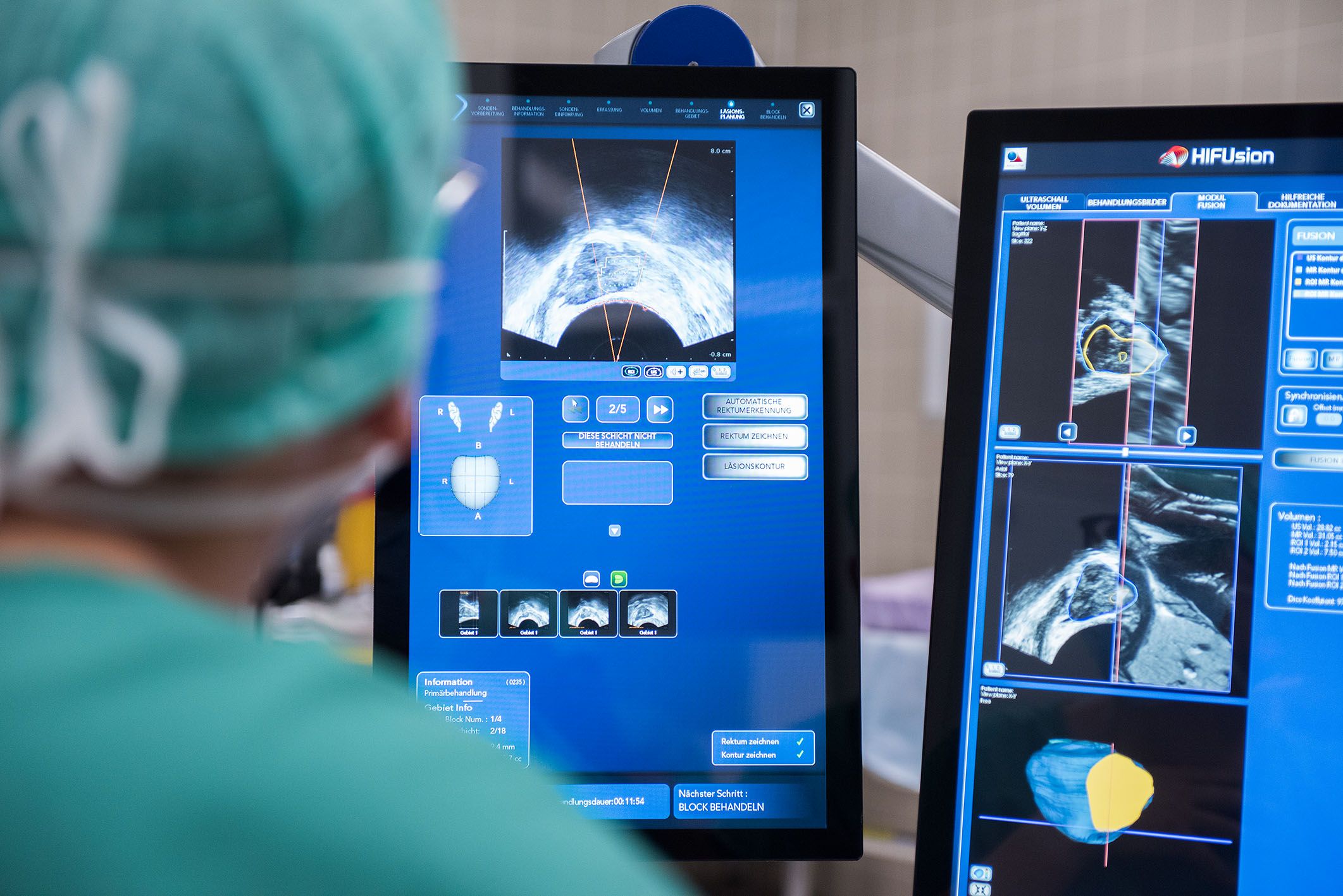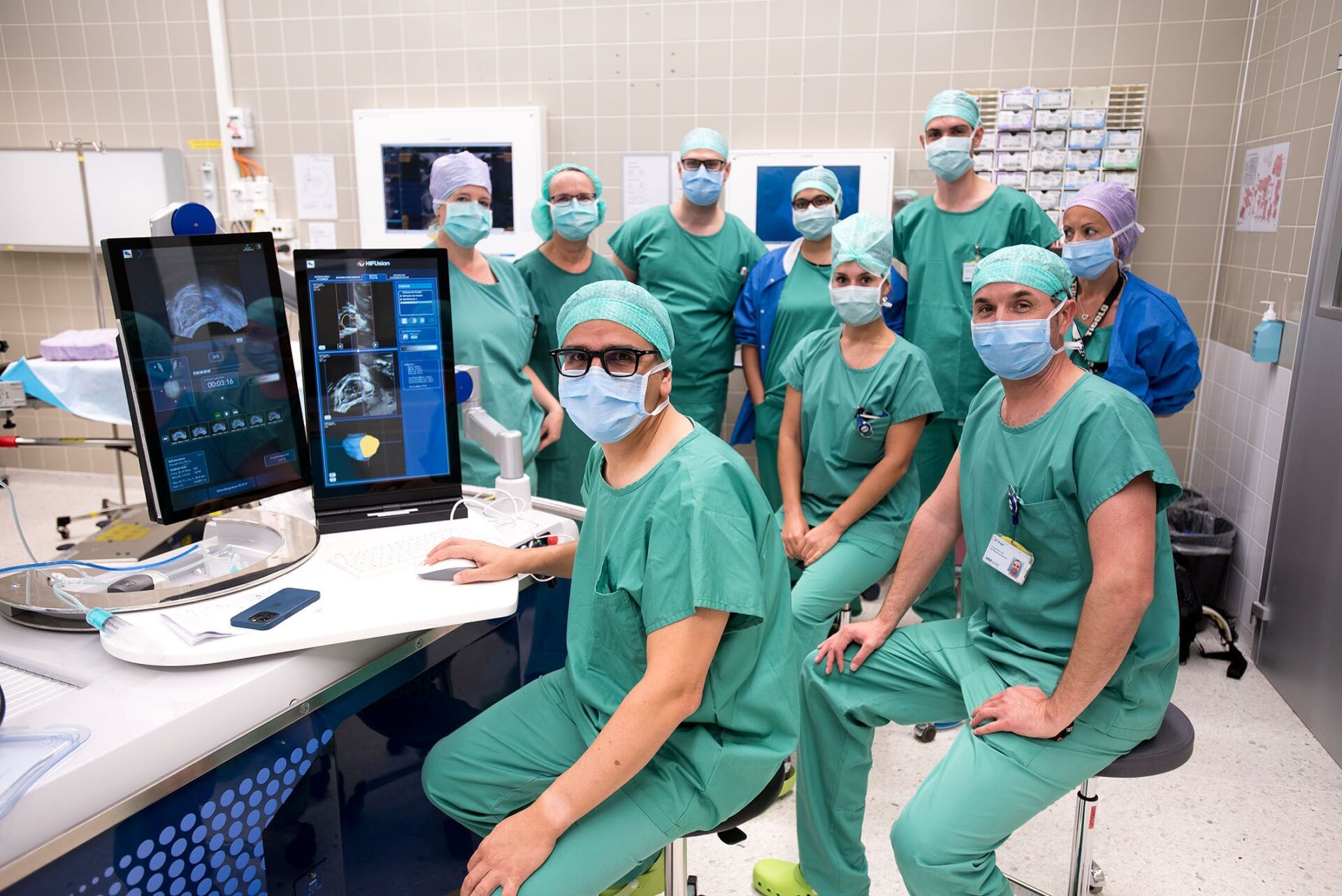What is HIFU therapy?
In HIFU treatment, ultrasound waves heat the tumor tissue to 90 degrees Celsius and ” boil away” the cancer cells in the prostate. The ultrasound waves are very precisely bundled (focused) in one place and destroy the tumor focus with millimeter precision. A special cooling system ensures that the healthy tissue around the prostate cancer is not damaged and thus the function of the organ is preserved. The physician controls the ultrasound probe, which is inserted through the rectum, from a computer console while the patient lies on the treatment table.
For the HIFU procedure to work so precisely, it requires special imaging technology. Before the procedure, magnetic resonance imaging (MRI) scans of the prostate are taken. The HIFU device meshes the MRI images taken with real-time 3D ultrasound images during the procedure to provide an accurate image of the tumor.
Detailed information on HIFU therapy can be found in this brochure:
Pinpoint: The focal treatment of prostate cancer
What are the advantages of HIFU therapy?
HIFU treatment is a minimally invasive procedure for localized prostate cancer. The method has the following advantages:
- No incisions in the skin
- No external scars
- Precise removal of the tumor focus with millimeter accuracy
- Low blood loss
- Short anesthesia time
- Hardly any pain
- Reduced risk of complications such as involuntary urinary leakage (incontinence) or erectile dysfunction (impotence)
- Short hospital stay of two to three days
- Usually no subsequent rehabilitation necessary

For whom is the treatment suitable?
The treatment chosen for prostate cancer depends on several factors:
- Are there one or more tumor sites in the prostate?
- How far has the cancer spread?
- How aggressively does the cancer grow into surrounding tissue?
HIFU therapy is used exclusively for localized prostate cancer of low to moderate aggressiveness. HIFU can also be used as a time-release treatment for recurrent cancer after radiation.
At the USZ, we offer novel genetic tests to assess tumor aggressiveness. Cancer tissue removed during prostate biopsy can be analyzed by molecular biology. The test results allow clear conclusions to be drawn about tumor spread and aggressiveness. This allows an informed assessment of which treatment option, whether active observation, HIFU or prostate removal, is appropriate.
Get a consultation at the University Hospital Zurich to find out whether HIFU therapy is an option for you. HIFU therapy also has special advantages for international patients. The duration of hospitalization after surgery is short and follow-up treatment can easily take place in the patient’s home country.
For international patients
Are you planning medical treatment in Switzerland? Would you like to have a Skype consultation? We are here for you with pleasure!
How does the HIFU treatment proceed?
The procedure lasts between 30 minutes and two hours and depends on the size and spread of the prostate cancer. During the operation, the patient receives a partial anesthesia (spinal anesthesia or Spinal Cord Anesthesia) or a general anesthesia. In the case of partial anesthesia, a sleeping pill is also administered so that the patient can lie relaxed and quiet.
The ultrasound probe is inserted into the bowel at the beginning of the treatment and creates a three-dimensional image of the prostate. Together with magnetic resonance imaging (MRI) images taken prior to the procedure, the result is a highly accurate image of the prostate with the tumor tissue clearly visible. The physician marks the boundaries of the prostate on the screen and determines which areas will be treated.
The HIFU device sends high-energy ultrasound waves that are directed at the prostate from the ultrasound probe in the rectum. A type of burning glass bundles the ultrasound waves so that they are directed (focused) to a point in the tumor. At this focal point, the tissue is heated to such an extent that it burns. The surrounding tissue, such as nerve structures, intestines, bladder or urethra, remains unharmed. HIFU therapy is thus a minimally invasive procedure. HIFU therapy is thus a minimally invasive procedure.
What aftercare is needed?
Immediately after the procedure, a urethral catheter is necessary to allow the urine to drain properly. In some patients, a catheter is also placed through the abdominal wall into the bladder before surgery. The catheter can be removed after about three to eight days, when the prostate has healed.
Studies have shown that HIFU therapy is a very safe method. Therefore, it is sufficient to check the PSA (prostate specific antigen) every three months after treatment. Six and twelve months after therapy, respectively, MRI and follow-up biopsy are recommended. Check-ups can be performed at the USZ or at a hospital close to home. If prostate cancer cells reappear, HIFU therapy can be repeated six months after the initial procedure.
What does HIFU treatment cost?
HIFU therapy has been a mandatory benefit of Swiss health insurers since July 2023.
Why to USZ?
The USZ offers university-based, internationally recognized cutting-edge medicine and is one of the best hospitals in the world. No matter what health challenge you face, we work closely together across disciplines to quickly find a diagnosis and create an individualized treatment plan for you. Our hospital is located in the heart of Zurich and right next to Zurich Airport.


